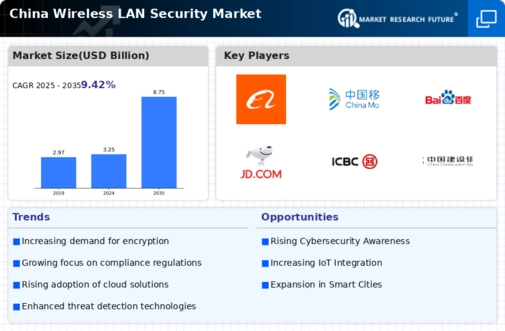The China Wireless LAN Security Market is an increasingly vital sector as the demand for secure wireless communication continues to grow. This market is characterized by rapid technological advancements and evolving security threats, prompting businesses to prioritize robust wireless security solutions. Various players are competing in this space, offering a wide range of products and services aimed at enhancing wireless network protection against unauthorized access, data breaches, and other cyber threats.
Market dynamics are influenced by regulatory developments, customer preferences, and the competitive strategies adopted by industry leaders. As organizations across various sectors recognize the importance of securing their wireless communications, the competitive landscape in this market becomes more energized, with companies continuously innovating to meet evolving security needs.ZTE has established a significant presence in the China Wireless LAN Security Market, thanks to its extensive portfolio of networking solutions and strong emphasis on research and development. The company is recognized for its cutting-edge technology that aids organizations in bolstering their wireless security frameworks.
ZTE emphasizes user-friendly interfaces and streamlined integration processes, which enhance the overall customer experience when implementing wireless LAN security measures. A notable strength of ZTE lies in its ability to adapt to the rapidly changing market demands and its commitment to sustainability and eco-friendly practices, positioning it favorably among consumers increasingly concerned with environmental impact. The company's strong foothold in the telecommunications field allows it to leverage synergies, further reinforcing its competitive edge in wireless LAN security.
Extreme Networks is another significant entity in the China Wireless LAN Security Market, delivering comprehensive networking solutions that encompass security features integrated within its offerings. The company excels in providing a range of key products and services that cater to diverse market needs, including advanced wireless security protocols, network management tools, and support services that ensure optimal performance and security.
Extreme Networks has cultivated a strong market presence in China, largely attributed to strategic partnerships and collaborations that enhance its service delivery and customer engagement. The company focuses on innovation, continuously refining its product offerings to address emerging security challenges in wireless networks. Furthermore, Extreme Networks has engaged in mergers and acquisitions that have bolstered its technological capabilities and market access, enabling it to provide enhanced solutions tailored to the unique demands of the China market while strengthening its position in the competitive landscape.

















